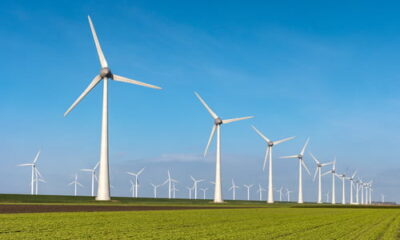

Economy
Digital energy: how can web technology be used for energy behaviour change?
Sonny Masero, managing director of GALOS.co, explains how ‘cleanweb’ can be utilised to change our energy behaviour.
I was recently asked by Forum for the Future to speak at an event called ‘Digital energy: how can web technology be used for energy behaviour change?’ to a mixed audience of investors, corporations and start-ups. There were a range of directions in which this discussion could be taken and I wanted to complement Benjamin Kott and his experiences with EnergyDeck‘s commercial and social housing customers.
I talked about how technology can be used to accelerate behaviour change in how we consume energy both as consumers and in businesses. At a personal level, the motivators for change can be very similar – status (individual and corporate), reward (financial, promotion, peers), showcasing and fun are some examples – and these can manifest in different combinations within a business. For a fuller picture of behaviour change motivators, I would suggest a look at the Futerra Changemaker Cards, available for free from www.Futerra.co.uk.
My theme for the talk was not a specific company, although I do work with EnergyDeck and DemandLogic who are active in this area. My interest, is in the power of the cleanweb. The cleanweb is the use of web technology to tackle global environmental challenge. This is a unique combination of web technology and clean technology; definitely an ‘and’ not an ‘either/or’. There are a number of reasons why I say this:
1. The Power of Free is a new economic dynamic enabled by software delivered through the web which has a unique strength. It has the ability to reduce the marginal cost of customer acquisition and servicing towards zero, in many cases at least too small to matter.
What do I mean? For a company like DemandLogic to add an additional customer they need only a small box of electronics to connect an existing building management system (BMS) to the internet and their software hosted in the cloud. Their big data analytics can then be used to identify wasted energy and actions to save time and money. The challenge is then to efficiently sell the value of this subscription service in identifying large energy savings.
This is not the case for traditional cleantech businesses nor traditional enterprise software businesses; each of these are installed on a project by project basis with unique costs on each occasion. In many cases, this presents an opportunity for tailored or even bespoke customer requests reducing the ability to replicate with ease.
This software-led technology revolution creates a novel business dynamic and approach to product development which is new to cleantech. The financing and risk management can change fundamentally through rapid aggregation. SolarCity is a prime example which is now being replicated by others. SolarCity has aggregated a large number of domestic and commercial solar photovoltaic (PV) projects, which they’ve then used to create innovative financing mechanisms. They now plan to install 500 megawatts (MW) of solar PV on US homes in 2014. First mover advantage makes a big difference here compared to larger barriers to entry for hardware businesses.
Less capital intensive software development means that a minimum viable product can be made available in months rather than years. New features and functionality can be tested live in beta with an existing customer community. This adds up to a more agile business which can use capital more efficiently. It can also create a bubble of expectations that is not underpinned by tangible value, but Nest Labs is a success story where they have combined sexy hardware with a data model that has delivered a 20-times return for their investors. The Climate Corporation also succeeded last year with a $1 billion acquisition by Monsanto.
2. Scaling quicker is an attribution of this agility of software and being capital-lite, which means that new markets can be reached more quickly. This is scale that was not possible for energy hardware before web technologies and business models began to mature, even for large corporations as well as start-ups and SMEs. This unique cleanweb combination changes the economics for these businesses. I’ve already mentioned SolarCity, but you will see this rapid aggregation model happen for energy efficiency projects.
3. Utilise network and systems science. Whilst traditional energy tech can exist as discrete projects, a cleanweb solution is built on the principle of networking individuals or things. Etsy and Open Utility are examples of how a peer-to-peer network can be used to support the making economy and distributed energy generation. This type of network creates a source of data, which can be valuable in its own right. It can also create a community of interest. When this is done well, the web solution can increase the rate of learning within the community, and can over time be automated within the solution.
This combination of elements to deliver a fast rate of learning creates a more rapid change in the behaviours we see in the consumption of energy. Let me give you an example. Opower has used different tactics to engage consumers: using responsibility to encourage people to reduce energy because it would help save the planet, an approach which didn’t work at scale and appealed to those already converted. They then switched to the obvious choice of saving money, a reward for reducing energy, but what finally worked at scale was a behaviour change tactic focused on creating the new ‘normal’ and ‘status’. In this case, the status of an individual homeowners amongst their neighbours.
Are you the odd one out, using more or less energy than your neighbours? This tactic has been so successful for Opower’s 90 or so utility customers that they have now saved the same amount of energy as is needed by cities like San Francisco or Milan for a whole year. That’s savings of 2-4% across approximately 22 million consumers.
There are many tried and tested tactics for behaviour change. It is usually a combination of two or three tactics that work on us as individuals to make a different decision. This can be a marketing or sales tactic, but it can also be your other half getting their way. If cleanweb technologies can incorporate these tactics through a desirable user experience for active users they can make the feedback loop more direct and therefore faster, plus the technology can aggregate the responses automatically so that they learn at scale.
How could this cleanweb technology look to accelerate behaviour change?
1. Social networks that reinforce peer support and status highlighting whether you are the leader or the odd one out. Like 10:10, it can also be used to showcase the best to help visualise what action could be taken and how you could look if successful.
2. Timely (Big) Data: better quality and more timely information for identifying the right action, making that behaviour change action required very specific, managable and delivered at the right time when you might be predisposed to a change in behaviour. Locatable is an example of a property service now looking at energy benchmaking. Why is this interesting? Because they expect to have an audience of homeowners who are making a change in their home and therefore in a transition zone when they could be more susceptible to suggestions about making other changes like reducing energy consumption through retrofit measures.
3. Faster, data driven feedback for learning from mistakes as well as successes so that poor behaviour can be stopped and the successes replicated. Demand Logic does this by focusing on wasted energy. Providing real time feedback to building operators about which assets in their building are not working as they should be.
4. Easier action (automation): the better data and faster learning can be used for better recommendations, making the utility to act more relevant and can lead to automation. Automation is a desirable outcome for energy efficiency operations, but still lacking in many building environments that are not highly specialised operations.
5. Fun and reward through gamification. See Practically Green which provides a service to companies to engage employees in adopting more environmentally-friendly behaviour. Providing an online platform for scoring points, receiving badges and for making suggestions on what further actions can be taken. Leaderboards and team rankings can add an extra incentive.
Used effectively, the cleanweb can be utilised to speed up our actions to reduce energy consumption and use low-carbon distributed energy generation. The cleanweb also provides opportunity to find alternatives to high-carbon travel. See Loco2, a website designed to make it easier to book pan-European train travel and farming. See eCow, which collects and analyses data on ruminant healthcare to allow their diet to be optimised for health and productivity.
The UK cleanweb sector is new and emerging. Over the next few months, I will be completing a market scoping study with funding from Nesta to identify which companies are active in this market, what scope is there for new innovation and where is the support coming from for these innovators and entrepreneurs. The results will be published later this year. For more information on the cleanweb see www.cleanweb.org.uk and www.cleanweb.co.
Sonny Masero is managing director of GALOS.co. He is an investor, advisor and part-time director for a range of companies active in the cleanweb market.
Photo: Stephen Gibson via stock.xchng
Further reading:
Technology: Let’s make this country the best
Intelligence Squared: Water, Food, Energy, Climate – Smart Solutions for 2050
Cleantech venture investment at $6.8bn in 2013, led by energy efficiency
Global cleantech industry worth $170bn after growing 18% in 12 months


 Environment10 months ago
Environment10 months agoAre Polymer Banknotes: an Eco-Friendly Trend or a Groundswell?

 Environment12 months ago
Environment12 months agoEco-Friendly Home Improvements: Top 7 Upgrades for 2025

 Features9 months ago
Features9 months agoEco-Friendly Cryptocurrencies: Sustainable Investment Choices

 Features10 months ago
Features10 months agoEco-Friendly Crypto Traders Must Find the Right Exchange





























